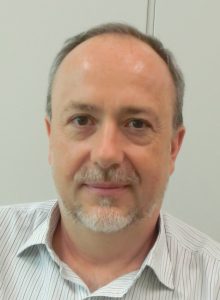Professor Tomáš Hanke – Use of Experimental Medicine for Rational Development of an Effective HIV Vaccine
The UNAIDS estimates that 38 million people currently live with human immunodeficiency virus (HIV) infection. Combination antiretroviral treatment has had great success in saving lives but is also associated with numerous medical and public health challenges. Vaccination remains the best and most cost-effective option for controlling HIV infection across the world. Professor Tomáš Hanke jointly from the University of Oxford, UK, and Kumamoto University, Japan, designs vaccines and coordinates clinical programmes testing the most advanced vaccine candidates developed by his team in the UK, Europe, USA and Africa.
End AIDS with Vaccination
Human immunodeficiency virus (HIV) type 1 represents 95% of all HIV infections worldwide and is responsible for the global HIV pandemic. If untreated, HIV-infected patients develop acquired immunodeficiency syndrome – better known as AIDS – that manifests as a progressive failure of their immune system. As a result, patients eventually succumb to opportunistic infections. Combination antiretroviral treatment (cART) has transformed the lives of people living with HIV, and dramatically decreased AIDS-related mortality and onward transmission of HIV.
Unfortunately, the provision of cART to everybody who needs it faces many obstacles particularly in low- and middle-income countries. The cost, complexity of the treatment, necessity of regular monitoring of patients, threat of drug resistance, side effects, social stigma and the use of cART to prevent HIV infections (or pre-exposure prophylaxis), which further stretches the cART supply, make cART a suboptimal therapeutic and an unlikely stand-alone tool to end the HIV epidemic. Therefore, an effective vaccine for both prevention and cure of HIV is urgently needed.
Professor Tomáš Hanke and his team at the Jenner Institute at the University of Oxford, UK, together with their collaborators at the Joint Research Center for Human Retrovirus Infection, Kumamoto University, Japan, are studying T cell responses to HIV to inform vaccine development. In addition, Professor Hanke oversees Experimental Medicine trials of his leading T-cell vaccine candidates in healthy and HIV-positive people at several global sites and collaborates with prestigious universities and organisations such as the International AIDS Vaccine Initiative, IrsiCaixa AIDS Research Institute-HIVACAT in Spain, Imperial College London, the Kenya AIDS Vaccine Initiative-Institute for Clinical Research and National Institute of Allergy and Infectious Diseases. He also co-ordinates the ‘Globally Relevant AIDS Vaccine Europe-Africa Trials Partnership’ consortium, acronymed GREAT, which builds research capacity and tests vaccine candidates in Eastern and Southern Africa, and is one of the principal investigators of the European AIDS Vaccine Initiative 2020.

Rational Iterative Development
Most of today’s HIV vaccine research focuses on antibody-mediated immunity, which neutralises cell-free viruses and typically involves exposing people to the outer HIV spike. However, to achieve HIV control, antibodies may need to be complemented by T-cell responses, the focus of Professor Hanke’s research. There is no doubt that T cells contribute in an important way to anti-HIV immunity, whereby CD8 T cells known as ‘killer cells’ directly kill virus-infected cells, the virus factories, and CD4 T cells or ‘helper cells’ assist and co-ordinate antibody and T-cell induction. ‘The trick is to induce not just any, but protective killer T cells that can slow or stop HIV,’ explains Professor Hanke.
The first clinically tested vaccine that Professor Hanke and his colleagues developed was called HIVA. It was derived from an African clade A strain of HIV and was tested in over a dozen clinical trials. Following the field’s full appreciation of the HIV’s enormous ability to change, Professor Hanke improved his approach by focusing vaccine-elicited T cells on the functionally conserved regions of HIV, which are common to most HIV strains and essential for virus survival. If successful, such a vaccine could be deployed universally in all global regions.
The prototype conserved immunogen was called HIVconsv (to emphasise conserved in addition to consensus sequences) and assembled highly conserved HIV regions into a chimeric protein alternating the global major HIV strains. This vaccine showed encouraging results in initial small clinical trials and informed the design of the second-generation conserved vaccines called HIVconsvX. Notable HIVconsvX improvements include the use of bioinformatics to redefine conserved regions and increase the vaccine match to the global HIV variants by using a so-called ‘mosaic’ design. The HIVconsvX vaccines entered clinical evaluation in 2019 with further trials in the pipeline.

The Importance of Vaccine Vectors
The quality of vaccine-elicited T-cell responses is strongly influenced by the way HIV immunogens are introduced into the body. The utmost priority is safety and Professor Hanke and his colleagues test all potential vaccine vectors intended for human use in mice and macaques first. The three most promising modalities that progressed in combination to human studies were 1) plasmid DNA, 2) engineered adenovirus of chimpanzee origin, the parent of which causes a common cold-like disease in monkeys, and 3) a poxvirus modified vaccinia virus Ankara (MVA), an attenuated smallpox vaccine used safely in many people during the smallpox eradication campaign. None of these three vaccines is replication-competent and can grow in the vaccinees’ body or spread to the environment; they are safe.
The HIVA vaccine was delivered by a combination of DNA and MVA and induced only weak T-cell responses mainly because of the inefficient DNA prime. Induction of T cells by the HIVconsv vaccines was greatly improved by the addition of the chimpanzee adenovirus. However, the adenovirus-MVA combination without DNA was as good as all the three vectors together and was therefore chosen for further studies.
HIVconsv vaccination-induced strong T cells that recognised multiple sites on the HIV. Vaccine-elicited T cells in HIV-negative volunteers in Nairobi, Kenya, were capable of a broad cross-clade inhibition of HIV under laboratory conditions. The HIVconsv vaccines were also tested in ‘kick-and-kill’ studies in early treated HIV-positive individuals. During infection, HIV integrates into the host chromosome, stops expressing its proteins (‘falls asleep’) and becomes invisible to the immune system, but regularly reactivates. This means that to eliminate HIV from the body, all sleeping HIV first needs to be awakened, or ‘kicked’ before it can be killed by the vaccine-induced killer T cells.
In a small pilot ‘kick-and-kick’ study in Barcelona, Spain, the HIVconsv vaccines together with an HIV-reactivating drug provided a signal of sustained suppression of HIV replication after stopping cART. Although a marginal result, it was very encouraging and warranted further testing of the ‘kick-and-kill’ strategy with these vaccines as an HIV cure.

Understanding the Consequences of HIV Variability
A successful vaccine needs to elicit killer T cells capable of reaching HIV-infected cells and killing them to stop virus growth. To be safe and effective, the killer T-cell assault must be sufficiently specific and efficiently target vulnerable parts of the HIV from the very first exposure to the virus. However, HIV is extremely variable and this makes it very good at avoiding the T-cell attack and escaping. There is lots of supporting evidence that people’s genetic makeup, the sites on HIV that killer T cells target and HIV escape are the major determinants of how well individuals fight HIV and scientists need to understand these processes in great detail.
Some T-cell responses are better at protecting than others. In the past, attempts to understand which parts of HIV should be targeted for protection often looked at responses to the whole virus and/or full-length virus proteins as units. This blurred the analysis because within each protein there are both stable and variable regions and these are not equally protective. Professor Hanke’s strategy exploits the stable and therefore vulnerable parts on HIV proteins.
This idea was supported by studies of Professor Hanke’s colleagues at Kumamoto and Tokyo Universities. HIV-infected patients, who never received any cART, controlled HIV better and were healthier (had more CD4 cells in the blood) if they targeted the same regions as used in the vaccine. This is an important observation endorsing this vaccine approach.

The Quest for Improvement
Although Professor Hanke’s strategy is rational and, so far, supported by good experimental results, many challenges remain on the road to an effective T-cell vaccine.
To be efficient, T-cell responses must, upon HIV exposure/reactivation, rapidly reach the sites of HIV growth within the patient’s body, kill infected cells and produce anti-HIV chemicals, be in sufficient numbers, and recognise multiple vulnerable regions at the same time to make escape difficult. It is plausible that if any one aspect of these T-cell properties is suboptimal, the vaccine may fail.
Professor Hanke and his colleagues study T-cell responses induced by HIV infection and vaccination in order to further refine the vaccine immunogens and their vector delivery. Novel and sometimes small but significant step-by-step improvements are tested in pre-clinical investigations and human trials. ‘Iterative improvements are best informed by human data, the only species that ultimately matters,’ says Professor Hanke.
Finally, new-born babies, children and adolescents, some of whom have acquired HIV perinatally, that is, via mother-to-child transmission, or babies who are exposed to HIV through mother’s milk, remain somewhat unique populations because of their young and, if treated soon after birth, relatively preserved immune system. To date, there have been several hundred HIV vaccine trials in humans, but only a very few tested candidate HIV vaccines in these age groups. Yet, childhood vaccines are the biggest success of vaccinology. Professor Hanke and his colleagues tested the HIVA vaccine in African neonates as the first step towards preventing mother-to-child transmission through breastfeeding and are planning to revisit these age groups using the conserved mosaic vaccines.
Reference
https://doi.org/10.33548/SCIENTIA538
Meet the researcher

Tomáš Hanke, BSc, MSc, PhD
Distinguished Professor
Kumamoto University
Kumamoto
Japan
Born in Prague, Czechoslovakia, Professor Tomáš Hanke started at Charles University reading Chemistry and completed his BSc in Biochemistry at McMaster University, Canada, followed by an MSc specialised in Herpes simplex virus immunology. He then completed a PhD focused on HIV vaccines at St Andrews University in Scotland, UK. In 1994, he started a postdoctoral fellowship at the University of Oxford where he is now a Professor of Vaccine Immunology at the Jenner Institute. Since 2015, he has taken a part-time appointment at the University of Kumamoto, Japan as Distinguished Professor. This was initially in the International Research Center for Medical Sciences, and since 2019, in the Joint Research Center for Human Retrovirus Infection. Professor Hanke’s work is balanced between translational and basic research with the primary goal of contributing to the development of an effective HIV-1 vaccine. He has coordinated a translational programme assessing candidate HIV vaccines at a number of sites in Europe, USA and Africa and built research capacity at several sites in Africa. With numerous international collaborations, Professor Hanke’s laboratory innovations aim to stay one step ahead of the clinical testing.
CONTACT
E: tomas.hanke@ndm.ox.ac.uk
W: https://www.ndm.ox.ac.uk/principal-investigators/researcher/tomas-hanke
http://ircms.kumamoto-u.ac.jp/research/tomas_hanke/
http://www.great-partnership.eu
Twitter: @HankeTomas
KEY COLLABORATORS
Professor Masafumi Takiguchi, Kumamoto University, Japan
Professor Christian Brander, IrsiCaixa AIDS Research Institute-HIVACAT, Spain
Dr Beatriz Mothe, IrsiCaixa AIDS Research Institute-HIVACAT, Spain
Dr Bette Korber, Los Alamos National Laboratory, USA
Dr Patricia Fast, International AIDS Vaccine Initiative, USA
Professor Walter Jaoko, University of Nairobi, Kenya
Professor William Kilembe, Zambia Emory HIV Research Partnership, Zambia
Professor Pontiano Kaleebu, MRC/UVRI & LSHTM, Uganda
Professor Sarah Fidler, Imperial College London, UK
Professor Barton Haynes, Duke University Medical Center, USA
Professor John Mellors, University of Pittsburgh, USA
Professor Nilu Goonetilleke, University of North Caroline, USA
Professor Gabriella Scarlatti, San Raffaele Scientific Institute, Italy.
Professor Robin Shattock, Imperial College London, UK
Professor Lucy Dorrell, University of Oxford, UK
Professor Sir Andrew McMichael, University of Oxford, UK
FUNDING
Medical Research Council (MRC) UK/UK Department for International Development (DFID)
International AIDS Vaccine Initiative (IAVI)
The European & Developing Countries Clinical Trials Partnership (EDCTP)
European Union’s Horizon 2020 Research and Innovation
IrsiCaixa AIDS Research Institute-HIVACAT and Fundació Gloria Soler, Spain
Ministry of Education, Science, Sports, and Culture, Japan
National Institute of Allergy and Infectious Diseases, USA

Want to republish our articles?
We encourage all formats of sharing and republishing of our articles. Whether you want to host on your website, publication or blog, we welcome this. Find out more
Creative Commons Licence
(CC BY 4.0)
This work is licensed under a Creative Commons Attribution 4.0 International License. 
What does this mean?
Share: You can copy and redistribute the material in any medium or format
Adapt: You can change, and build upon the material for any purpose, even commercially.
Credit: You must give appropriate credit, provide a link to the license, and indicate if changes were made.
More articles you may like
Grandmothers: Innovation Through Tradition
Grandmother Project – Change through Culture (GMP) is an organisation dedicated to documenting the role of grandmothers and demonstrating the effectiveness of grandmother-inclusive strategies in improving the health and well-being of women, children, and adolescents. GMP’s groundbreaking work challenges conventional wisdom to transform community-based interventions in Africa and beyond, harnessing a powerful but often overlooked resource: the wisdom and influence of grandmothers.
Dr Robert Larkin | Cultivating Change to Improve Soil Health and Increase Potato Yield
Environmental quality and food production are facing the pressing challenges of climate change and global population growth. Dr Robert Larkin from the United States Department of Agriculture-Agricultural Research Service (USDA-ARS) and a team of plant scientists developed and tested a range of crop management systems to help overcome these compounding challenges. Their work is improving soil health and increasing the yield of potato crops, contributing to the future food security of nations.
Professor Giorgio Buttazzo | Artificial Intelligence and a Crossroads for Humanity
Where do we stand with artificial intelligence? Might machines take over our jobs? Can machines become conscious? Might we be harmed by robots? What is the future of humanity? Professor Giorgio Buttazzo of Scuola Superiore Sant’Anna is an expert in artificial intelligence and neural networks. In a recent publication, he provides considered insights into some of the most pressing questions surrounding artificial intelligence and humanity.
Dr Ralf Adam | New Technologies Shaping the Future of Oral Hygiene
Understanding the efficiency of various toothbrush technologies is essential for achieving optimal oral health. Dr Ralf Adam, who leads a dedicated team at Procter & Gamble in Germany, is keen to investigate the complexities of these technologies. His team have provided new insights into the best toothbrush types for plaque removal and the maintenance of gum health. By highlighting the importance of informed oral care decisions and ongoing investigations, this vital research works towards ensuring everyone can achieve a brighter, healthier smile.




